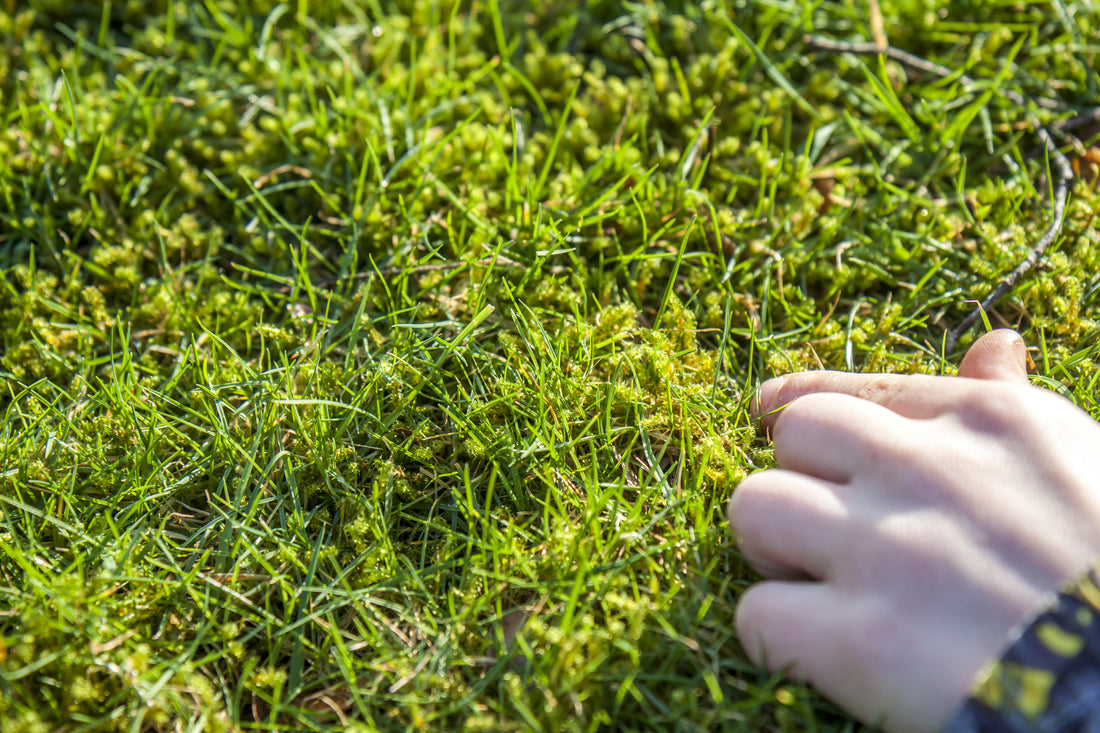For many, moss evokes an almost ethereal image of it bathing a forest floor with beds of soft green, the patterns formed as it climbs up trees, or mosses cloaking the rocks near a stream or waterfall. However beautiful in the right setting, the small flowerless plants are less attractive when growing in the wrong places - like our gardens and on our lawns.
Moss in lawns
There are over 10,000 different moss species in the world, and the UK is home to 600 of them! Most are found in natural areas such as woodlands etc. but there are several different types that can grow in our lawns. Moss is considered a nuisance and a weed due to its negative impact to lawns; and if left to spread, can take over the grass. Though moss spreads easily and can grow on all soil types, its presence doesn’t mean a lawn is doomed! Moss can be eradicated/prevented if the conditions favourable to its growth are removed.
Moisture is essential to moss survival and it thrives in damp/shady conditions. Mosses do not produce seeds, and instead reproduce and spread using spores. All mosses lack roots, and are attached to the surfaces from which they grow by tiny structures called rhizoids.
Here are some of the most common moss species found in UK lawns:
Common lawn mosses
- Trailing Moss:
Feather-like in appearance
Symptomatic of poor drainage
Common in lawns
- Cushion Forming Moss:
Forms upright clusters (or cushions)
Generally found on lawns that have been regularly cut too short, or have bare soil
- Upright Moss:
Often called vertical tufted
Very stubborn
Symptomatic of low PH levels, i.e. acidic soil
Generally found at the base of trees
Why is a lawn moss a problem?
Moss is troublesome for those who want a thriving lawn. It not only impacts a lawn’s appearance but also affects health.
Negative effects
- If untreated, moss will die off in summer (due to low moisture levels) but leave unsightly bald patches
- Roots less able to receive essential water and nutrients
- Grass has to compete with moss for growing space
- Uneven colour and surface – lawn is spongy underfoot
There’s more…
- Moss in lawns can cause soil erosion by providing surface cover and absorbing water
- Moss creates a locally humid environment and in turn, a home for invertebrates such as slugs
- Some birds tug moss from lawns, hoping to find tasty creatures underneath – causing patches and also encouraging the spread of moss in other parts of the lawn
Why it grows in lawns:
One of the main culprits is excess moisture in the lawn – creating perfect conditions for moss to grow, as it is 90% water. Presence of moss can sometimes suggest underlying lawn issues.
Here are some common causes, and how to get rid of lawn moss – show the moss who’s boss!
PROBLEM: excess thatch
- Thatch is a layer of dead/dying organic matter below the visible grass
- Moss loves thatch - it stores a lot of moisture, creating the ideal conditions in which moss grows
SOLUTION: scarification
The best way to remove thatch, as well as dehydrated moss
PROBLEM: too much moisture
- Moss thrives in wet soils with poor surface drainage
- Can be also be caused by excess wet weather
SOLUTION: aeration
- Creates open spaces in the soil - greatly assisting drainage
- Prevents waterlogged conditions on the lawn surface
PROBLEM: shade
Lawn mosses thrive in all-day shade, especially beneath trees/under debris on the lawn such as leaves
SOLUTION: increase direct sunlight
- Remove fallen leaves and other debris from the lawn
- Trim back lower branches of trees, overhanging shrubs etc.
PROBLEM: compacted soil
- When the ground is too hard, grass has difficulty growing and spreading which allows the moss to take over
- Severely compacted soil is almost impregnable - moss has no problem growing on the dense surface caused
SOLUTION: aeration
The very best way to relieve compacted soil
PROBLEM: mowing too close
- A scalped lawn allows moss to take over
SOLUTION: raise the height of cut
- We recommend you do not cut the lawn too short – never less than 1” in height
- Scalping the lawn weakens the grass plant and makes it more susceptible to moss invasion
PROBLEM: impoverished lawns
- An unhealthy lawn will struggle to compete with moss
SOLUTION: nourishment
- Our nutrient and micronutrient-rich feed encourages a much stronger lawn (and better colour as a bonus!) which allows the grass to compete better with moss
PROBLEM: dry/drought damaged soil
- As counter-intuitive as it may sound, given that moss loves moisture - loss of moisture causes the soil to shrink - making it tight and dense
- This can damage and tear roots, making it very difficult for them to receive essential water and nutrients
- When the lawn finally does receive moisture, opportunistic moss spores germinate quickly, as the grass is not healthy enough to compete
SOLUTION: Oasis
Our Oasis treatment is a wetting agent that conditions the soil and greatly improves absorption of any moisture received
Just one more thing…
Moss is also found on:
- Worn/overused areas: especially along walkways and where children play
- New-build lawns: sometimes due to poor site preparation
- Established lawns: usually due to poor health/stresses to the grass plant
- Tree roots: many people have trees in the garden - when larger roots grow close to the soil surface, the grass is prevented from having sufficient soil - this causes moss to develop and grow on top of the roots If the lawn is not watered sufficiently, the finer (sometimes microscopic) feeder roots of the tree can move upwards and compete with grass for water and space - weakening the grass plant and permitting moss to grow [This also can occur around shrubs bordering the lawn, especially evergreens]
GreenThumb to save the day!
To remain moss-free, a good lawn maintenance programme is essential, that’s where we come in! We can improve the vigour of the grass and address any other contributory factors.
NutraGreen Autumn/Winter: bespoke seasonal treatment
As well in lawns with damp/shady conditions, moss can appear in poorly maintained lawns. Moss seems to prefer poor quality soil and thrives among weak grass. Simply raking-out/removing moss will not prevent regrowth unless the conditions favourable to its growth are changed. Our treatment for autumn/winter improves lawn strength; being rich in iron, it makes lawns greener as well as better able to cope with adverse conditions.
Not only that, it also dehydrates moss – preventing it from reproducing. Once turned black by the treatment, moss can be removed from the lawn - the method of scarification helps reduce levels of thatch.
Our treatments result in a beautiful lawn as part of a partnership with you: for expert advice on mowing, or what else you can do to help prevent moss/reduce its spreading, just ask one of your local GreenThumb lawn experts, we’re here to help!

